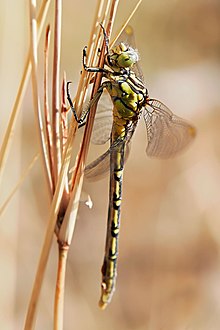Gomphidae
| Gomphidae | |
|---|---|
 |
|
| Austrogomphus guerini | |
| Scientific classification | |
| Kingdom: | Animalia |
| Phylum: | Arthropoda |
| Class: | Insecta |
| Order: | Odonata |
| Infraorder: | Anisoptera |
| Family: |
Gomphidae Rambur, 1842 |
| Genera | |
|
See text |
|
See text
The Gomphidae are a family in the Odonata commonly referred to as clubtail dragonflies; the family contains about 90 genera and 900 species. The name refers to the club-like widening of the end of the abdomen (abdominal segments 7 through 9). However, this club is usually less pronounced in females and is entirely absent in some species.
The name may be derived from Latin gomphus or gond meaning "hinge".
Clubtails have small, widely separated compound eyes, a trait they share with the Petaluridae and with damselflies. The eyes are blue, turquoise, or green. The thorax in most species is pale with dark stripes, and the pattern of the stripes is often diagnostic. They lack the bright metallic colors of many dragonfly groups and are mostly cryptically colored to avoid detection and little difference between the sexes is seen. Adults are usually from 40 to 70 mm (1.6 to 2.8 in) in length.
Clubtails are fast-flying dragonflies with short flight seasons. They spend much time at rest, perching in a suitable position to dart forth to prey on flying insects. They tend to perch on the ground or on leaves with the abdomen sloping up and its tip curling down a little. Larger species may perch with a drooping abdomen or lie flat on a leaf. Another stance adopted by clubtails perching in the open is "obelisking", standing with the abdomen raised vertically, a posture adopted otherwise only by the skimmers.
Most clubtails breed in streams, rivers, or lakes. The nymphs are unusual in having a flat mentum, part of the mouthparts, and their antennae have only four segments. They burrow in the sediment at the bottom of the water body, with the nymphs of the dragonhunter (Hagenius brevistylus) living among damp bark and leaf litter at the edge of the water.
Gomphidae wing structure: Note the similar-sized triangles of the front and hind wings and the widely separate eyes.
Pair of yellow-striped hunters mating
Common clubtail, Ictinogomphus rapax
Gomphus vulgatissimus, showing the "clubbed" abdomen characteristic of the family
...
Wikipedia
